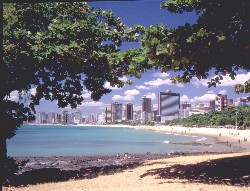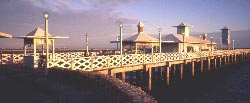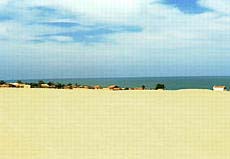Advertising by Google
Fortaleza, Ceará
Area: 314 km²
Population: 2 097 757 inhab. (est. 2000).
See map of Ceara.
See weather in Fortaleza.
The name Fortaleza means "Fortress". The first building in the what is called today Fortaleza was the Fortress Schoonenborch, built in 1649 by the Dutch, who at the time had invaded and were occupying cities in the Brazilian northeast, such as Recife and Natal. After the Dutch were expelled, the city changed name a few times, until settling with Fortaleza (read more about History of Ceara).
Two words define the capital of Ceará State: sun and party. Sun is absolute on 25 kilometers of beaches; Fortaleza is the Brazilian coastal city with most sunny days throughout the year. Party is the permanent state of spirit of the people and the city.
 Forró, typical musical style on the region of northeast, is on the people's blood, on the beaches, on the bars, on the restaurants, on the hotels, in the dance clubs, on the streets of Fortaleza.
Forró, typical musical style on the region of northeast, is on the people's blood, on the beaches, on the bars, on the restaurants, on the hotels, in the dance clubs, on the streets of Fortaleza.
If people's happiness and hospitality and the cultural animation are characteristics that make people love Fortaleza at the first sight, other elements also contribute to include the city on the required route of the visitor on Brazil's Northeast. Modern capital, it has become one of the preferred beach of Brazilian and Latin-American visitors due to the combination of a privileged nature with an excellent infra-structure, sophisticated tourist equipments, good reception and services. Besides, the government of Ceará is fully aware of the importance of tourism in the local economy, and the State is the one which makes most investments in marketing to attract tourists from Brazil and abroad.
Place of lobsters, Fortaleza has luxury hotels, resorts, excellent restaurants and bars, diversified commerce and an intense nightlife ensuring the best time to the visitors. Because of all these factors, each day more and more tourists are walking by the sidewalks on Meireles beach with shorts, slippers and colorful shirts, appreciating the poetic movement of the raftings (called, in Portuguese, jangadas).
 The capital of Ceará possesses one of the largest and best equipped networks of hotels and restaurants in the North East Region of Brazil. The Jangada is a kind of symbol of the city and lobster is one of its most typical dishes. The city has a hot climate and affords a warm reception to visitors, attracted mainly by the beauty of its beaches. Beach Park at Ponta das Dunas is the largest water park in Brazil, offering also one of the best hotel resorts in Brazil.
The capital of Ceará possesses one of the largest and best equipped networks of hotels and restaurants in the North East Region of Brazil. The Jangada is a kind of symbol of the city and lobster is one of its most typical dishes. The city has a hot climate and affords a warm reception to visitors, attracted mainly by the beauty of its beaches. Beach Park at Ponta das Dunas is the largest water park in Brazil, offering also one of the best hotel resorts in Brazil.
Fortaleza is celebrated in verse and prose as the "blonde bride of the sun". The sea shore, running the length of the city, has a variety of attractions. Iracema beach is a bohemian enclave, with dozens of all-night bars (Pirata being the largest one) situated in buildings which still retain the architectural features of the turn of the century. Its biggest attractions are the Estoril, which houses restaurants and an exhibition gallery, the Ponte dos Ingleses - Bridge of the Englishmen, from which beautiful sunsets can be observed, and the Cultural Center Dragão do Mar, one of the most modern and complete cultural centers in Brazil.
The most important urban beaches of Fortaleza are Meireles, Volta da Jurema and Mucuripe, connected to each other by the Avenida Beira-Mar. This three-mile long avenue is lined by modern buildings, including hotels, bars and restaurants which serve local
 cuisine and delicious sea food dishes. The Statue of Iracema, one of the landmarks of the city, is at Volta da Jurema. There is also the colony of fishermen at Mucuripe, with their jangadas, and Futuro beach, full of stalls where you can dance the forró.
cuisine and delicious sea food dishes. The Statue of Iracema, one of the landmarks of the city, is at Volta da Jurema. There is also the colony of fishermen at Mucuripe, with their jangadas, and Futuro beach, full of stalls where you can dance the forró.
Another landmark of Fortaleza is Praça do Ferreira, where local people meet to talk about politics and football. Also worth seeing is the José de Alencar Theatre, constructed in the nineteenth century, whose rich architecture and internal ironwork is a mixture of the neoclassical and art nouveau styles; the Museums of Railway History, the Automobile, Popular Art and Mineralogy; and the Central Market, where you can buy anything from lace clothing to liqueurs, cachaças and cashew nuts.
Read more:
 Fortaleza official site. Maintained by the city government.
Fortaleza official site. Maintained by the city government.
 Fortaleza. In English.
Fortaleza. In English.
 A Jangada. Commercial guide, with info on hotels, transportation, etc. In Portuguese only.
A Jangada. Commercial guide, with info on hotels, transportation, etc. In Portuguese only.
 Photos of Fortaleza. High quality photos of the major touristic points of Fortaleza.
Photos of Fortaleza. High quality photos of the major touristic points of Fortaleza.
 Universidade Federal do Ceará. The Federal University of Ceará, campus in Fortaleza.
Universidade Federal do Ceará. The Federal University of Ceará, campus in Fortaleza.
Back to Top